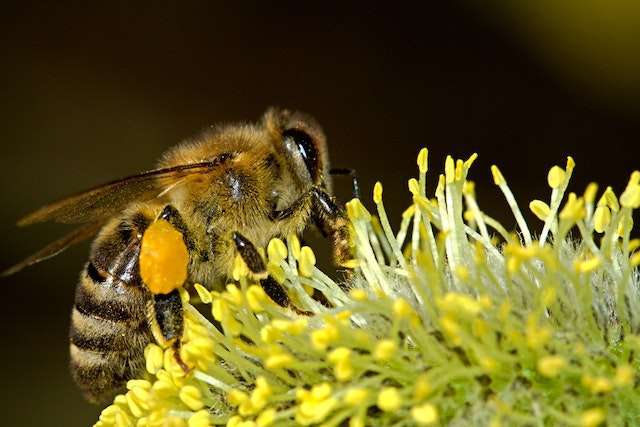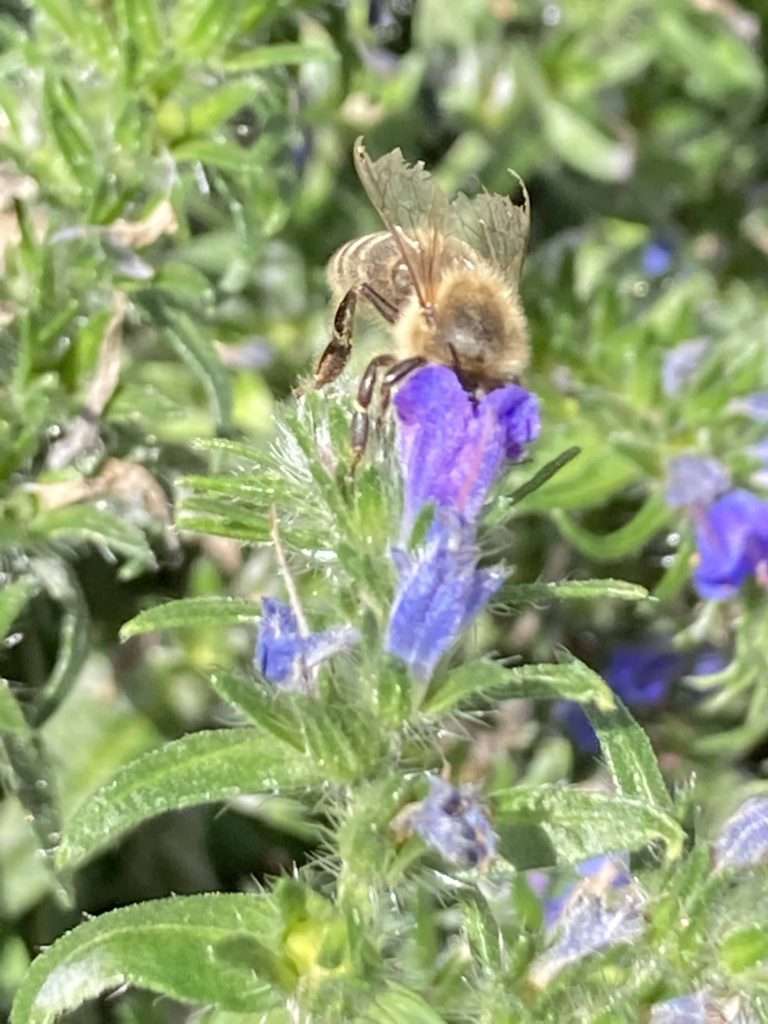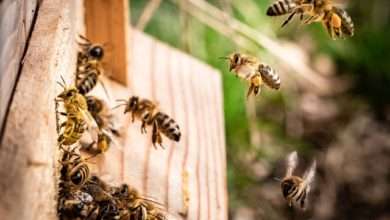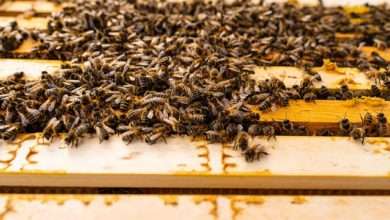The Top Plants to Attract Bees in Autumn: Boosting Pollination and Biodiversity

The autumn season is known for its cooler temperatures, changing foliage, and other unique outdoor activities. But did you know that by planting certain flowers and plants, you can help to attract bees in the fall?
Bees are incredibly important for our environment, as they are natural pollinators, responsible for transferring pollen from the male to the female parts of a plant, thus continuing the life cycle of flowers, vegetables, trees, shrubs and more. By choosing certain types of plants to add to your garden or planting site in the fall, you can help to attract bees, aiding in their natural ecology.
In this article, we will explore some of the best plants to attract bees in the fall, as well as how to create a bee-friendly environment.
The Crucial Role of Plants in Attracting Bees
Plants play a vital role in attracting bees, serving as a source of nectar and pollen that sustains their populations.
Not only do bees rely on these resources for their own survival, but they are also responsible for pollinating approximately 75% of the world’s flowering plants, including many crops that humans depend upon. By ensuring a diverse array of bee-friendly plants in our gardens, we can help support these industrious insects while significantly contributing to the overall health of our ecosystems.
Focus on Autumn: A Significant Time for Bee-Friendly Gardening:
While spring and summer are often perceived as the peak seasons for bee activity, autumn should not be overlooked. Many species of bees, such as honeybees and bumblebees, remain active during this time as they gather resources to sustain their colonies throughout the winter.
Moreover, autumn-blooming plants provide a crucial late-season source of nectar and pollen when other resources may become scarce. By focusing on autumn as a significant time for bee-friendly gardening, we can ensure a continuous supply of food for bees and contribute to their survival.
The Benefits of Attracting Bees in Autumn
As the temperature begins to cool and nature prepares for winter, bees play a crucial role in various aspects, including pollination, sustaining their populations, and promoting biodiversity and ecosystem health. Understanding these benefits empowers us to appreciate the significance of bees and take essential steps to protect and cultivate their presence during this critical time.
- Continued Pollination during Cooler Months for Crop Production
One of the primary advantages of attracting bees in autumn is their contribution to continued pollination during the cooler months. As summer ends and the days become shorter, many flowering plants begin to prepare for their dormancy period. However, several crops and plants still bloom during autumn, relying on bees for successful pollination.
Bees, with their unique ability to transfer pollen from male to female flowers, ensure the formation of seeds and fruits for various crops. By attracting bees to our gardens, orchards, and farms during this time, we can support the ongoing growth and development of these important plants, which ultimately leads to a bountiful harvest.
- Sustaining Bee Populations Before Winter Hibernation
Autumn also serves as a critical period for sustaining bee populations before they enter their winter hibernation phase. Bees are highly adaptive insects, and as the temperatures drop, they undergo significant physiological changes to survive the colder months. However, before entering hibernation, bees need to gather sufficient resources to sustain themselves and their colonies.
By ensuring that our surroundings provide an abundant and diverse supply of nectar and pollen, we can aid in the accumulation of vital food reserves for bees. This can be achieved by planting late-season flowering plants, such as asters, goldenrods, and sedums, which serve as valuable sources of nutrition. By attracting bees to these plentiful food sources, we contribute to the well-being and survival of bee populations throughout winter.
- Ensuring Biodiversity and Ecosystem Health
Beyond their role in pollination and sustaining their populations, attracting bees in autumn helps ensure biodiversity and ecosystem health. Bees are renowned pollinators, facilitating the reproduction of numerous plant species, including those that form the foundation of various ecosystems.
By attracting bees to our gardens, parks, and natural habitats, we encourage the pollination of a wide range of plants, promoting biodiversity at a crucial time when many species are preparing for the dormant season. This, in turn, supports the overall health and resilience of ecosystems by facilitating the reproduction of diverse plant species that provide habitats and sustenance for other organisms.
Additionally, bees also contribute to the overall health of ecosystems by promoting the genetic diversity of plants. As they visit flowers and transfer pollen, they facilitate the mixing of genetic material, ultimately resulting in stronger and more adaptable plant populations.
Factors to Consider for Bee-Friendly Gardening in Autumn
As the autumn season approaches, it is important for gardeners to be aware of the factors that contribute to creating a bee-friendly environment in their gardens.
By considering climate and regional factors, fostering plant diversity, and understanding bee preferences in terms of flower shapes, colors, and scents, gardeners can provide a welcoming habitat for various bee species in the autumn months.
Climate and Regional Considerations for Plant Selection
- Research your local climate: Before selecting plants for your bee-friendly garden, it is crucial to familiarize yourself with the climate and growing conditions in your region. This will help you choose plants that are well-suited to the specific temperature, rainfall, and soil conditions in your area.
- Native plant selection: Opt for native plant species as they are more likely to thrive in your region and provide valuable food sources for local bee populations. Native plants have adapted to the local climate and are often more resistant to pests and diseases, making them a sustainable choice for your garden.
The Importance of Plant Diversity in Attracting Various Bee Species
- A wide variety of flowering plants: To attract and support different bee species, it is essential to cultivate a garden with a diverse range of flowering plants. Different bee species have varying preferences for nectar and pollen sources, so having a mix of plants increases the chances of providing suitable food options for a wider array of bees.
- Extend the blooming season: Ensure that your garden provides a continuous supply of nectar and pollen throughout the autumn season. Select plants with different bloom times to maintain a steady food supply for bees, even as some flowers fade or go to seed. By extending the blooming season, you provide sustenance for late-season bees before winter.
Understanding Bee Preferences – Flower Shapes, Colors, and Scents:
- Flower shapes and structures: Bees have distinct preferences for flower shapes and structures. Many bee species are attracted to flowers with landing platforms, such as daisies and asters, which provide a stable surface for them to land while foraging for nectar and pollen. Tubular-shaped flowers, like those found in salvias or foxgloves, are favored by long-tongued bees.
- Colors that catch their eyes: Bees are particularly drawn to blue, purple, violet, white, and yellow flowers. Incorporate flowers in these colors to attract a variety of bee species to your garden. However, it’s important to note that different bees have different color preferences, so having a mix of colors is beneficial.
- Alluring scents: Bees rely on their sense of smell to locate flowers rich in nectar and pollen. Fragrant flowers, such as lavender, rosemary, or jasmine, can be enticing to bees. By planting flowers with pleasant scents, you can further attract bees and enhance the sensory experience in your garden.
The 8 Top Bee-Attracting Plants for Autumn
Here are some of the top bee-attracting plants for autumn, including their descriptions, preferred soil and lighting conditions, as well as their flowering period and attractiveness to bees.
Aster

- Asters are beautiful flowering plants that belong to the Asteraceae family. They come in a variety of colors, including purple, pink, blue, and white. These daisy-like flowers have a yellow center, and their petals radiate outwards, creating a stunning display.
- Asters prefer well-drained soil and full sun exposure. They can tolerate a range of soil types and are relatively low-maintenance plants. However, it is important to ensure they receive adequate sunlight for optimal growth and blooming.
- Asters bloom in late summer and throughout the autumn season, making them a perfect choice for bee-friendly gardening during this time. Their vibrant flowers attract bees, butterflies, and other pollinators, providing them with a valuable late-season food source.
Goldenrod
- Goldenrod is a perennial plant with bright yellow flowers that belong to the Solidago genus. It is often wrongly blamed for causing allergies, but its heavy, sticky pollen does not easily become airborne. The impressive plumes of goldenrod add a touch of warmth and beauty to any garden.
- Goldenrod thrives in well-drained soil and full sun. While it can tolerate different soil types, ensuring good drainage is essential for its growth. Additionally, it requires ample sunlight to support its abundant flowering.
- Goldenrod typically blooms from late summer to early autumn, coinciding perfectly with bees’ need for nectar and pollen. Bees are highly attracted to goldenrod due to its abundant and accessible nectar, making it a valuable late-season food source for them.
Sedum
- Sedum, also known as stonecrop, is a succulent plant that exhibits fleshy, thick leaves and gorgeous flower clusters. These clusters can range in color from pink and red to yellow and white, creating a visually stunning garden display.
- Sedum thrives in well-drained soil and requires at least six hours of direct sunlight each day. It can tolerate various soil types, including sandy and rocky soils. This low-maintenance plant is drought-tolerant, making it an excellent choice for gardens with dry conditions.
- Sedum typically blooms from late summer until early winter, providing bees with a valuable food source during the autumn months. Its vibrant flowers are highly attractive to bees due to their rich nectar content, making sedum a favorite among pollinators.
Helenium
- Helenium, also known as sneezeweed, is a perennial flowering plant that showcases vibrant daisy-like flowers. These flowers can vary in color, including shades of yellow, orange, and red. Additionally, helenium plants can reach an impressive height, adding vertical interest to any garden.
- Helenium thrives in moist, well-drained soil and requires full sun exposure for optimal growth. While it can tolerate a range of soil types, providing good drainage is crucial to prevent waterlogged conditions.
- Helenium blooms during late summer and continues into the autumn season, coinciding with bees’ foraging requirements. Bees are highly attracted to helenium flowers due to their rich nectar reserves and vibrant colors, making it a beneficial plant to include in bee-friendly gardens.
Solidago
- Solidago, commonly known as goldenrod, is a perennial plant that displays stunning clusters of tiny yellow flowers. These flowers grow on tall, upright stems, showcasing their beauty to the surrounding landscape.
- Solidago thrives in well-drained soil and requires full sun exposure for optimal growth. It can adapt to different soil types, including sandy or clay soil, making it a versatile plant to include in gardens.
- Solidago typically blooms from late summer to early autumn, providing bees with a much-needed nectar and pollen source during this time. Bees are highly attracted to its yellow flowers and rely on solidago to gather resources for their hives, making it a top choice for bee-friendly gardening in the autumn season.
Autumn Joy Sedum
- Autumn Joy Sedum is a popular succulent plant that exhibits stunning clusters of flowers. It showcases thick, succulent leaves, which take on a bluish-green color during the autumn months. As the name suggests, this plant adds a delightful touch of joy to any garden during the fall season.
- Autumn Joy Sedum thrives in well-drained soil and is known for its ability to tolerate various soil types, including poor soil. It prefers full sun exposure but can tolerate partial shade.
- Autumn Joy Sedum blooms from late summer throughout autumn. The flowers undergo a captivating transformation, starting as pale pink buds and developing into deep pink or rusty red clusters. Bees are highly attracted to Autumn Joy Sedum due to its bountiful nectar production, making it a valuable late-season food source for them.
Japanese Anemone
- Japanese Anemone is a charming perennial plant that adds elegance to any garden. It features delicate, cup-shaped flowers with multiple petals that come in various shades of pink and white. Japanese Anemone’s graceful and airy appearance makes it a favorite amongst gardeners.
- Japanese Anemones prefer moist, well-drained soil. They can thrive in both full sun and partial shade, making them adaptable to different lighting conditions.
- Bursting into bloom from late summer to autumn, Japanese Anemones offer a captivating floral display when most other plants are winding down. Bees are particularly attracted to their nectar-rich flowers, making them an essential late-season food source. These plants also provide a delicate landing pad for bees due to their layered petals.
Mexican Sunflower
- Mexican Sunflower is an impressive annual plant that reaches impressive heights, often growing up to six feet tall. It boasts vibrant orange or red-orange daisy-like blooms that create a visual spectacle in any autumn garden.
- Mexican Sunflowers prefer well-drained soil and thrive in full sun exposure. They are relatively drought-tolerant, making them suitable for warmer climates.
- Mexican Sunflowers bloom from mid-summer until the first frost, providing an extended feeding period for bees. Their vibrant, showy flowers serve as a beacon for bees, attracting them with copious amounts of nectar. Due to their substantial height, Mexican Sunflowers are easily visible to bees, allowing them to efficiently locate this valuable food source.
Creating a Bee-Friendly Environment
In addition to choosing the right plants to attract bees in the fall, there are a few steps that you can take to ensure that your garden is as bee-friendly as possible.
- Provide shelter. Bees need a place to call home, and providing them with shelter in your garden is essential. Look for natural items to serve as a structure for them, such as logs or birdhouses, as well as areas in which to hide from predators.
- Avoid pesticides. While pesticides are tempting to combat insects in the garden, they can be incredibly harmful to bees. Avoid using chemical pesticides as much as possible, and if you need to use them, be sure to use them sparingly if bees are present.
- Provide water. Bees may not seem to need water, but it’s actually an incredibly important element for their development. Find a shallow bowl of water and place it somewhere in the garden. This will help them to stay hydrated and healthy, thus ensuring their longevity.
- Keep the pollen rolling. The blooms of many popular plants don’t last very long, so it’s important to keep a steady rotation of blooming plants in your garden to ensure a more continually pollen source. This doesn’t mean that you have to fill your garden with flowers, but instead just keep a few seasonal plants that will provide more continual blooms.
Conclusion
We hope that this article has provided you with everything that you need to know to attract bees in the fall. By planting the right plants and taking into account some of the tips above, you can help to create a bee-friendly space and support the health and development of these critical pollinators.

FAQs
Why is attracting bees in autumn important for pollination and biodiversity?
- Attracting bees in autumn is crucial for maintaining a healthy ecosystem. Bees are vital pollinators that contribute to the reproduction of various plant species, which in turn helps sustain biodiversity and ensure food production.
How do the top plants in autumn benefit bees?
- The top plants selected for attracting bees in autumn provide an abundant and diverse source of nectar and pollen. Bees rely on these resources for energy and sustenance, and by planting these bee-friendly plants, we help support their wellbeing and population.
What are some examples of other plants to attract bees in autumn?
- Examples of the 8 top plants include astilbes, dahlias, Joe-Pye weed, and Russian sage. These plant species are known to produce large quantities of nectar and pollen, attracting bees and providing them with essential nourishment.
When is the best time to plant these bee-attracting plants?
- Late spring or early summer is typically the best time to plant these bee-attracting plants, providing them ample time to establish strong root systems before the autumn when bees actively forage for resources.
How can I ensure the safety of the bees when using these plants?
- To ensure the safety of bees, avoid using harmful pesticides in proximity to these plants. Opt for organic gardening practices, such as companion planting, and provide a pesticide-free environment for the bees to thrive.
Can these plants be grown in containers or smaller spaces?
- Yes, many of these plants can be grown in containers or smaller spaces with proper care and adequate sunlight. Choose the appropriate-sized containers and ensure proper drainage to support their growth.




